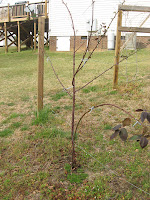A few years ago we tried our hand at blackberries. We read about the 3 main types and had no clue what that would look like in our area. We chose the trailing version because it was the middle ground. Now 1-2 years later we produce more than we can eat, unless I make blackberry freezer jam. Here's one of the main things we've learned.
Prune the plants during the dead season. Yes you'll find information that tells you to prune the stalks that produced berries leaving the newer ones to produce the following year but there's no research we found telling someone how to prune the NEW shoots. The new shoots will be the ones producing berries the following year. Below are pictures of our current plants. 1 shows a plant that was not pruned as a new shoot thus drastically produces less fruit. The other shows the plant that was pruned thus produces 3x the fruit. How does one prune the new shoot? Well as the leaves die all you need to do is bend them in the opposite direction until they fall off. If the leaf isn't dead it won't bend. Bending it will snap the old leaf thus allowing a new shoot to replace it.
Now why did we try this? Well as a plant grower I learned that pruning dead leaves produces new growth so I thought let's try it with blackberries and see what happens. Amazing results. The plants are drastically different and I wish I could get them to produce the same but I can't. 1 is definitely greater than another and the ONLY difference is the pruning. Pictures are the proof.
 Here's a picture showing me pushing back the old dead leaf/stem thus allowing new growth. You just want to bend it slightly in the opposite direction of it growing. See I'm bending it down when it was growing up.
Here's a picture showing me pushing back the old dead leaf/stem thus allowing new growth. You just want to bend it slightly in the opposite direction of it growing. See I'm bending it down when it was growing up. Here's another shot of me bending the dead stem in the opposite direction thus breaking it off for new growth.
Here's another shot of me bending the dead stem in the opposite direction thus breaking it off for new growth.


